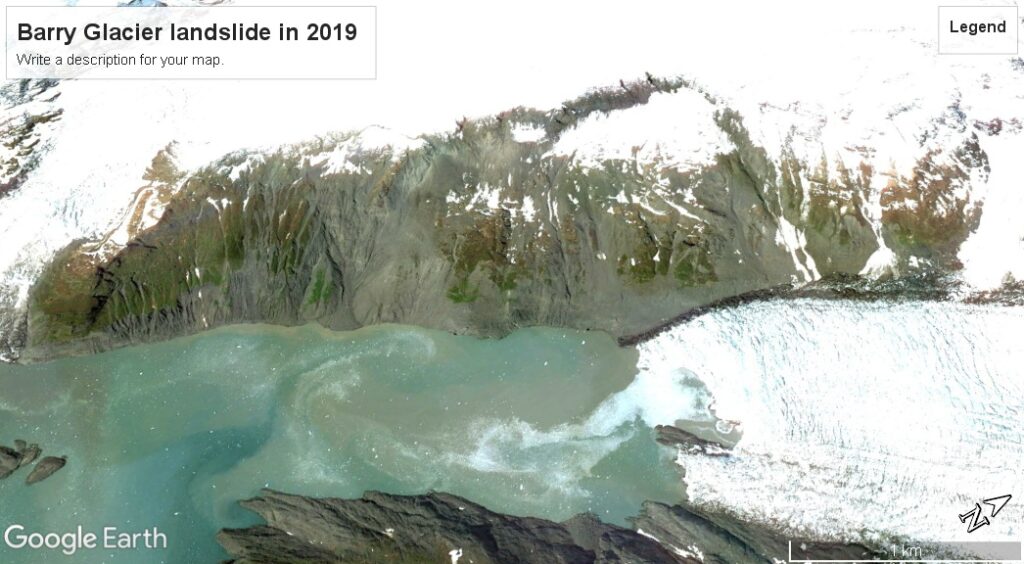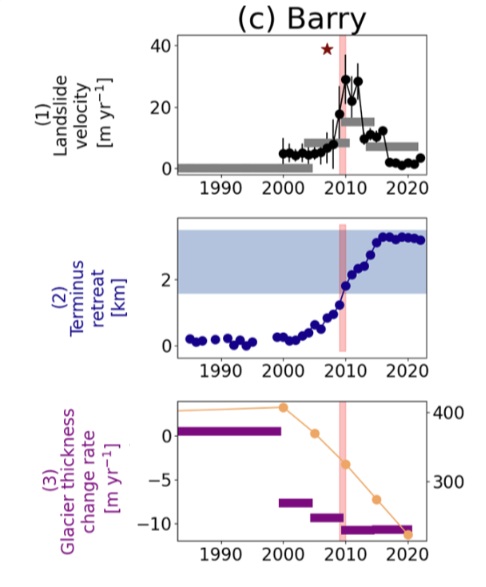An excellent new paper (Walden et al. 2025) examines the occurrence of accelerated movement in rock slope landslides in Alaska as adjacent glaciers melt.
The exceptional temperatures in recent days in both North America and Europe has once again highlighted the rate at which the climate is changing in response to anthropogenic increases in greenhouse gases. In most glaciated areas, retreat of the large ice masses is occurring. There has long been discussion of how the slopes adjacent to glaciers will respond to these changes.
There is a very good new open access paper (Walden et al. 2025) in the journal Natural Hazards and Earth System Sciences that examines this issue for eight landslides in southern coastal Alaska. These are large, rock slope failures in areas in which the adjacent glaciers are retreating rapidly. In some cases, the glacier has already retreated beyond the slope, leaving it bordering lakes or fjords. In other cases, the slope is still in contact with the ice, which is in retreat.
On of these landslides is at the actively retreating Barry Glacier – this is a very large rock slope failure, with an estimated volume of between 188 and 500 million cubic metres. This is a Google Earth image of the site in 1996:-

And this is the same site in 2019:-

And here is a slider to allow the images to be compared:-


The change in the glacier is, of course, startling, but the large rock slope landslide is also notable.
Walden et al. (2025) have used archive datasets extending back to the 1980s to examine these eight slopes as the glaciers below them changed. They found that six of the slopes have experienced a period of substantially increased rates of movement. In four sites, a pronounced acceleration was observed as the terminus of the glacier retreated past the landslide area. Two other sites showed rapid movement during a period of wet weather or as the glacier rapidly thinned. In two cases, the sites did not appear to undergo a change in behaviour.
This is illustrated by data from the Barry Glacier site. This is a part of Figure 4 from Walden et al. (2025), showing the measured landslide velocity (upper graph), the retreat of the terminus of the glacier (middle graph) and the change in thickness of the Barry glacier (lower graph). The pink shading shows onset of rapid movement. The slope underwent a really rapid phase of movement (over 20 metres per year) as the adjacent glacier thinned and the slope started to debuttress.

Key parts of the original caption:
“Landslide and glacier evolution at the study sites. Row 1: landslide velocities from ITS-LIVE (black circles, with uncertainty estimates) and manual feature tracking (gray bars). Stars indicate the onset of slope-wide deformation, triangles stand for crack opening, and diamonds mean both deformation and crack opening. Row 2: terminus retreat (dark blue) and location of the landslide along the glacier centerline (light-blue shading). Row 3: glacier thickness change rates (purple) and absolute ice thickness (yellow; right-hand axis) below the landslide. … In all panels, light-red shading indicates the onset of landslide movement.
Large rock slopes are incredibly complex, and the ways in which they interact with their environment (including an adjacent glacier, but also rainfall, seismic forcing and suchlike) is also complex, so we would not expect them all to respond in the same way. But this study is important for two reasons.
First, it provides additional support for the notion that glacial debuttressing is an important element of the geomorphology of areas undergoing glacial retreat.
But second, large rock slope failures can be very hazardous, either through direct impact from the resulting rock avalanche or as a result of the generation of a localised displacement wave. This study once again highlights the need to monitor these types of slope better, to undertake hazard analyses and to ensure that local populations are prepared for the consequences of a rapid collapse event.
Reference
Walden, J., Jacquemart, M., Higman, B., Hugonnet, R., Manconi, A., and Farinotti, D. 2025. Landslide activation during deglaciation in a fjord-dominated landscape: observations from southern Alaska (1984–2022), Natural Hazards and Earth System Sciences, 25, 2045–2073, https://doi.org/10.5194/nhess-25-2045-2025.


